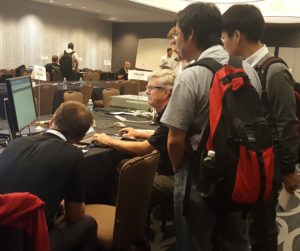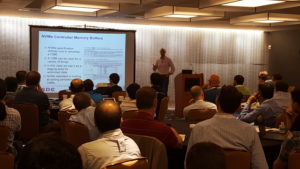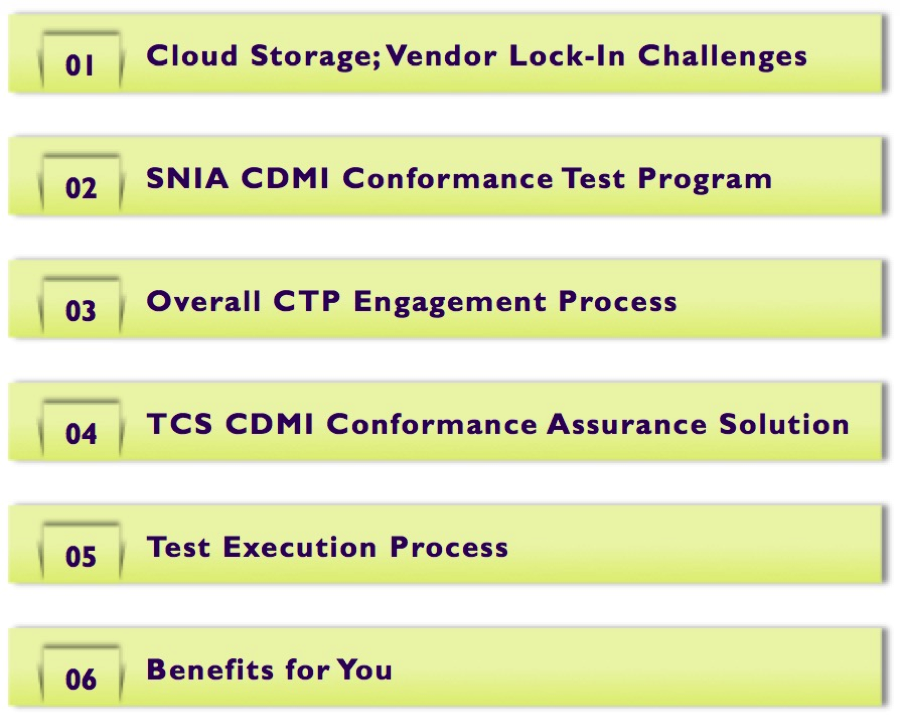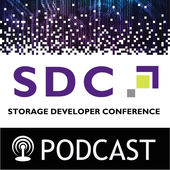Category: Cloud Standards
Learn How to Develop Interoperable Cloud Encryption and Access Control
SNIA Cloud is hosting a live webcast on December 20th, “Developing Interoperable Cloud Encryption and Access Control,” to discuss and demonstrate encrypted objects and delegated access control. For the data protection needs of sharing health and other data across different cloud services, this webcast will explore the capabilities of the Cloud Data Management Interface (CDMI) in addressing these requirements and show implementations of CDMI extensions for a health care example.
See it in action! This webcast will include a demonstration by Peter van Liesdonk of Philips who will share the results of testing at the SDC 2016 Cloud Plugfest for Encrypted Objects and Delegated Access Control extensions to CDMI 1.1.1.
You’ll will see and learn:
- New CDMI features (Encrypted Objects and Delegated Access Control)
- Implementation experiences with new features
- A live demo of a healthcare-based example
Register today. My colleagues, Peter van Liesdonk, David Slik and I will be on-hand to answer any questions you may have. We hope to see you there.
SNIA Storage Developer Conference-The Knowledge Continues
SNIA’s 18th Storage Developer Conference is officially a success, with 124 general and breakout sessions; Cloud Interoperability, Kineti c Storage, and SMB3 plugfests; ten Birds-of-a-Feather Sessions, and amazing networking among 450+ attendees. Sessions on NVMe over Fabrics won the title of most attended, but Persistent Memory, Object Storage, and Performance were right behind. Many thanks to SDC 2016 Sponsors, who engaged attendees in exciting technology discussions.
c Storage, and SMB3 plugfests; ten Birds-of-a-Feather Sessions, and amazing networking among 450+ attendees. Sessions on NVMe over Fabrics won the title of most attended, but Persistent Memory, Object Storage, and Performance were right behind. Many thanks to SDC 2016 Sponsors, who engaged attendees in exciting technology discussions.
For those not familiar with SDC, this technical industry event is designed for a variety of storage technologists at various levels from developers to architects to product managers and more. And, true to SNIA’s commitment to educating the industry on current and future disruptive technologies, SDC content is now available to all – whether you attended or not – for download and viewing.
 You’ll want to stream keynotes from Citigroup, Toshiba, DSSD, Los Alamos National Labs, Broadcom, Microsemi, and Intel – they’re available now on demand on SNIA’s YouTube channel, SNIAVideo.
You’ll want to stream keynotes from Citigroup, Toshiba, DSSD, Los Alamos National Labs, Broadcom, Microsemi, and Intel – they’re available now on demand on SNIA’s YouTube channel, SNIAVideo.
All SDC presentations are now available for download; and over the next few months, you can continue to download SDC podcasts which combine audio and slides. The first podcast from SDC 2016 – on hyperscaler (as well as all 2015 SDC Podcasts) are available here, and more will be available in the coming weeks.
SNIA thanks all its members and colleagues who contributed to make SDC a success! A special thanks goes out to the SNIA Technical Council, a select group of acknowledged industry experts who work to guide SNIA technical efforts. In addition to driving the agenda and content for SDC, the Technical Council oversees and manages SNIA Technical Work Groups, reviews architectures submitted by Work Groups, and is the SNIA’s technical liaison to standards organizations. Learn more about these visionary leaders at http://www.snia.org/about/organization/tech_council.
And finally, don’t forget to mark your calendars now for SDC 2017 – September 11-14, 2017, again at the Hyatt Regency Santa Clara. Watch for the Call for Presentations to open in February 2017.
Cloud Storage: Solving Interoperability Challenges
Cloud storage has transformed the storage industry, however interoperability challenges that were overlooked during the initial stages of growth are now emerging as front and center issues. I hope you will join us on July 19th for our live Webcast, “Cloud Storage: Solving Interoperability Challenges,” to learn the major challenges facing the use of businesses services from multiple cloud providers and moving data from one cloud provider to another.

We’ll discuss how the SNIA Cloud Data Management Interface standard (CDMI) addresses these challenges by offering data and metadata portability between clouds and explain how the SNIA CDMI Conformance Test Program helps cloud storage providers achieve CDMI conformance.
Join us on July 19th to learn:
- Critical challenges that the cloud storage industry is facing
- Issues in a multi-cloud API environment
- Addressing cloud storage interoperability challenges
- How the CDMI standard works
- Benefits of CDMI conformance testing
- Benefits for end user companies
You can register today. We look forward to seeing you on July 19th.
Podcasts Bring the Sounds of SNIA’s Storage Developer Conference to Your Car, Boat, Train, or Plane!
SNIA’s Storage Developer Conference (SDC) offers exactly what a developer of cloud, solid state, security, analytics, or big data applications is looking for – rich technical content delivered in a no-vendor bias manner by today’s leading technologists. The 2016 SDC agenda is being compiled, but now you can get a “sound bite” of what to expect by downloading SDC podcasts via iTunes, or visiting the SDC Podcast site at http://www.snia.org/podcasts to download the accompanying slides and/or listen to the MP3 version.
can get a “sound bite” of what to expect by downloading SDC podcasts via iTunes, or visiting the SDC Podcast site at http://www.snia.org/podcasts to download the accompanying slides and/or listen to the MP3 version.
Each podcast has been selected by the SNIA Technical Council from the 2015 SDC event, and include topics like:
- Preparing Applications for Persistent Memory from Hewlett Packard Enterprise
- Managing the Next Generation Memory Subsystem from Intel Corporation
- NVDIMM Cookbook – a Soup to Nuts Primer on Using NVDIMMs to Improve Your Storage Performance from AgigA Tech and Smart Modular Systems
- Standardizing Storage Intelligence and the Performance and Endurance Enhancements It Provides from Samsung Corporation
- Object Drives, a New Architectural Partitioning from Toshiba Corporation
- Shingled Magnetic Recording- the Next Generation of Storage Technology from HGST, a Western Digital Company
- SMB 3.1.1 Update from Microsoft
Eight podcasts are now available, with new ones added each week all the way up to SDC 2016 which begins September 19 at the Hyatt Regency Santa Clara. Keep checking the SDC Podcast website, and remember that registration is now open for the 2016 event at http://www.snia.org/events/storage-developer/registration. The SDC conference agenda will be up soon at the home page of http://www.storagedeveloper.org.
Enjoy these great technical sessions, no matter where you may be!
Moving Data Protection to the Cloud: Key Considerations
Leveraging the cloud for data protection can be an advantageous and viable option for many organizations, but first you must understand the pros and cons of different approaches. Join us on Nov. 17th for our live Webcast, “Moving Data Protection to the Cloud: Trends, Challenges and Strategies” where we’ll discuss the experiences of others with advice on how to avoid the pitfalls, especially during the transition from strictly local resources to cloud resources. We’ve pulled together a unique panel of SNIA experts as well as perspectives from some leading vendor experts Acronis, Asigra and Solid Fire who’ll discuss and debate:
- Critical cloud data protection challenges
- How to use the cloud for data protection
- Pros and cons of various cloud data protection strategies
- Experiences of others to avoid common pitfalls
- Cloud standards in use – and why you need them
Register now for this live and interactive event. Our entire panel will be available to answer your questions. I hope you’ll join us!
Embrace the Cloud at SNIA’s Storage Developer Conference With These Top-Notch Speakers and Sessions!
For the next two weeks, SNIA on Storage will highlight exciting interest areas in the 2015 SNIA Storage Developer Conference (SDC) agenda. If you have not registered, you need to! Visit www.storagedeveloper.org to see the four day overview and sign up.
Cloud storage is hot, and whether you are new to the cloud or an experienced developer, SDC has a great lineup of speakers and sessions. Preview sessions here, and click on the title to find more details.
If you are just dipping your toes into cloud technology, you will want to check out the SDC Pre-Conference Primer on Sunday September 20. These sessions are included with full conference registration.
Here, SNIA Cloud Storage TWG Co-Chairs, David Slik and Mark Carlson, will explain all you Need to Know on Cloud Storage. You will come up to speed on the concepts, conventions, and standards in this space, and even see a live demo of an operating storage cloud. And Brian Mason, MTS-SW at NetApp, will review how to use REST API for Management Integration and how developers can use their best in class management tools and have various storage systems integrate into their management tools.
At the SDC Conference, the Cloud track kicks off with David Slik, SNIA Cloud Storage TWG Co-Chair and Technical Director at NetApp, discussing how to Use SNIA’s Cloud Data Management Interface (CDMI) to Manage Swift, S3, and Ceph Object Repositories, and how the use of CDMI as a management protocol adds value to multi-protocol systems.
Yong Chen, Assistant Professor at Texas Tech University will speak on Unistore: A Unified Storage Architecture for Cloud Computing. He will introduce an ongoing effort from Texas Tech University and Nimboxx Inc. to build an innovative unified storage architecture (Unistore) with the co-existence and efficient integration of heterogeneous HDD and SCM devices for Cloud storage.
Luke Behnke, VP of Products at Bitcasa will present The Developer’s Dilemma: Do-It-Yourself Storage or Surrender Your Data? He’ll discuss the choice between DIY or cloud storage APIs, and how this will impact future functionality and user experience.
Sachin Goswami, Solution Architect and Storage COE Head Hi Tech, Tata Consultancy Services ((TCS), will explain How to Test CDMI Extension Features Like LTFS, Data Deduplication, and OVF, Partial – Value Copy Functionality: Challenges, Solutions and Best Practices, sharing the approach TCS will adopt to overcome the challenges in testing of LTFS integration with CDMI, Data Deduplication, partial upload on Server and Open Vitalization format (OVF) of CDMI and Non-CDMI based scenarios of the cloud.
Speaking of the CDMI standard, join the Cloud Plugfest at SDC starting on September 21st to learn more about the CDMI Conformance Test Program and test your application for CDMI conformance.
And you won’t want to miss the Birds-Of-a-Feather (BOF) Sessions on Cloud! The first is on Tuesday evening, September 22, on Getting Started with the CDMI Conformance Test Program! Come to this OPEN TO ALL Birds of a Feather session to learn what the CTP program entails, details on the testing service that is offered, and how to get the CTP process started.
On Wednesday evening, September 23, the Moving Data Protection to the Cloud: Trends, Challenges and Strategies BOF will discuss critical cloud data protection challenges, how to use the cloud for data protection, pros and cons of various cloud data protection strategies, experiences of others (good and bad) to avoid common pitfalls, and cloud standards in use – and why you need them! This BOF is open to all!
Register now at www.storagedeveloper.org. And stay tuned for tomorrow’s blog on Management topics at SDC!
LTFS Bulk Transfer Standard Q&A
Our recent live SNIA Cloud Webcast “LTFS Bulk Transfer Standard” is now available on-demand. Thanks to all the folks who attended the live event. We did not have time to address all of the questions, so here are answers to them. If you think of additional questions, please feel free to comment on this blog.
Q. The LTFS standard seems to support shared extents between files, and by extension, deduplicated files. Is this a correct assessment, and how does it play in the bulk transfer standard?
A. The LTFS Bulk Transfer Standard supports shared extents as supported by the LTFS standard, which can transparently reduce space used by having multiple references to common data stored on tape (deduplication). This typically happens below the bulk transfer layer, by the software used to read and write the LTFS volumes. At this point, few software packages support this feature due to the wear and latency consequences of read seeks resulting from using this feature.
Q. What is the state of the standard in its lifecycle? (e.g., working group draft, public review, published, etc.)
A. The LTFS standard has been around for some time; more information can be found here at http://www.snia.org/tech_activities/standards/curr_standards/ltfs. The LTFS Bulk Transfer Standard is here at http://www.snia.org/tech_activities/publicreview#ltfsbulk, and is in public review.
Q. The standard seems to be based on the idea of moving physical tapes to the cloud. Is there a definition of a virtual LTFS image that can be moved between systems over the network?
A. Not yet, but that is a great idea we’ll be taking forward in the next versions of the proposal.
Q. One of the barriers to greater use of LTFS in the Cloud is the relative lack of enterprise grade management software that ensures that the tape media is refreshed / upgraded as it ages, that its integrity is periodically checked, that reclamation and compaction is done. It needs open standards for support in standard volume management systems as well. Until these things are in place, LTFS will be interesting largely to specialized industries like film/entertainment, seismic, and bulk transfer & bulk storage — but not about the steady-state use of tape as a true additional layer of the cloud storage hierarchy. Tape with LTFS plus proper management could fill this role — but not until the full lifecycle tape management is available and integrated.
A. The management that is always required for a physical product with a well-defined and finite lifetime is not a unique requirement of LTFS. Tape has a long history of use as a backup and archive medium, and there are a number of tape management products that are commercially available from LTO tape suppliers and independent software companies, as well as open source products. A Google search for “tape management software” will provide you with a number of alternative solutions.
Q. Do you have a list or people that sell LTFS based solutions?
A. No we don’t, but it’s a very good idea, and we’ll investigate it further.
New SNIA-CSI Webcast: LTFS Bulk Transfer Standard
Mark your calendar for February 10th as we conclude our Cloud Developer’s series by hosting a live Webcast on the LTFS Bulk Transfer Standard. LTFS (Linear Tape File System) technology provides compelling economics for bulk transportation of data between enterprise cloud storage.
This Webcast will provide an update on the joint work of the LTFS and Cloud Technical Working Groups on a bulk transfer standard that uses LTFS to allow for the reliable movement of bulk data in and out of the cloud, and mechanisms for verification, error handling and the management of namespaces. Register now to hear David Slik, Co-Chair of the SNIA Cloud Storage Technical Work Group, discuss:
- LTFS standard mandate and history
- LTFS adoption and use cases
- LTFS bulk transfer to, from, and between clouds
- Error handling and recovery
- Security considerations
I’ll be hosting the event, taking your questions, and hopefully shedding some light on the importance of this standard. I hope you’ll join us.
What’s New in the CDMI 1.1 Cloud Storage Standard
On December 2, 2014, the CSI is hosting a Developer Tutorial Webcast “Introducing CDMI 1.1” to dive into all the capabilities of CDMI 1.1.
Register now to join David Slik, Co-Chair, SNIA Cloud Storage Technical Work Group and me, Alex McDonald, as we’ll explore what’s in this major new release of the CDMI standard, with highlights on what you need to know when moving from CDMI 1.0.2 to CDMI 1.1.
The latest release – CDMI 1.1 – includes:
- Enabling support for other popular industry supported cloud storage protocols such as OpenStack Swift and Amazon S3
- A variety of extensions, some part of the core specification and some stand-alone, that include a CIMI standard extension, support for immediate queries , an LTFS Export extension, an OVF extension, along with multi-part MIME and versioning extensions. A full list can be found here.
- 100% backwards compatibility with ISO certified CDMI v. 1.0.2 to ensure continuity and backward compatibility with existing CDMI systems
- And more
This event on December 2nd will be live, so please bring your specific questions. We’ll do our best to answer them on the spot. I hope you’ll join us!